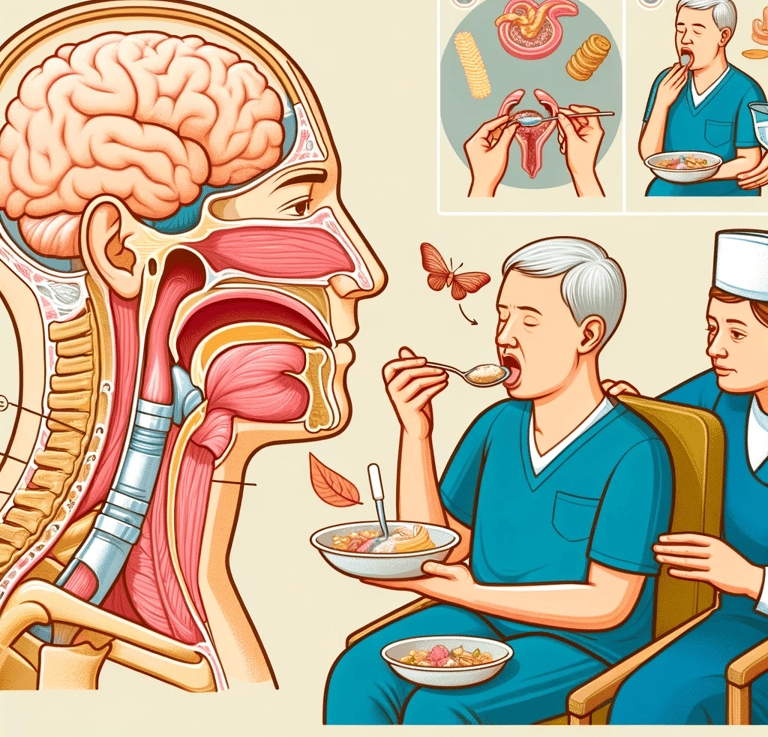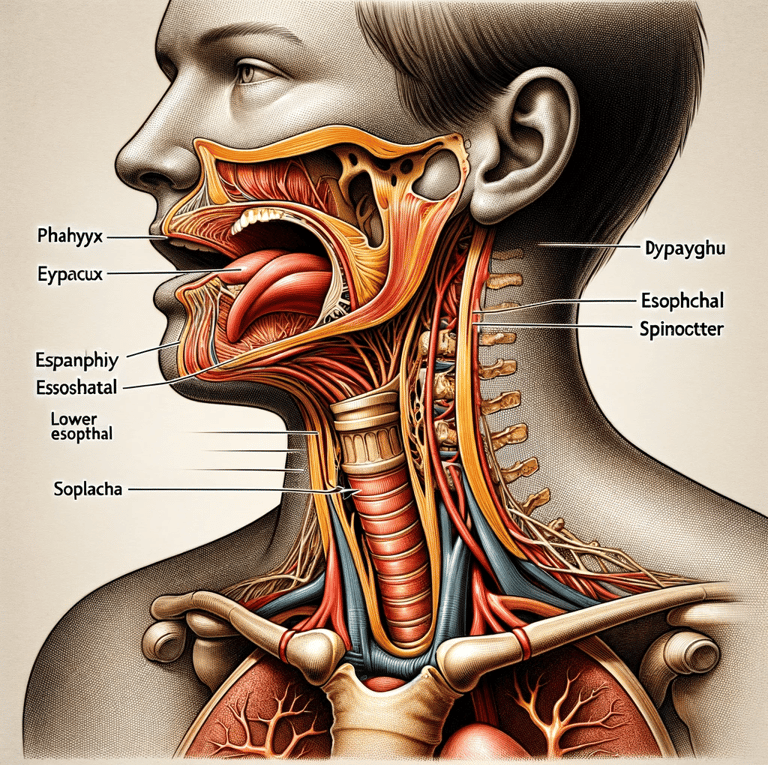Dysphagia
In the vast field of medicine, certain conditions present unique challenges to patients and their caregivers. Dysphagia, a swallowing disorder, is one of these conditions. It affects the ability to eat and drink comfortably and often profoundly impacts the quality of life and personal independence


Introduction:
In the vast field of medicine, certain conditions present unique challenges to patients and their caregivers. Dysphagia, a swallowing disorder, is one of these conditions. It affects the ability to eat and drink comfortably and often profoundly impacts the quality of life and personal independence.
This course is to illuminate the mysteries of dysphagia. Together, we will explore the physiological aspects of this condition and its social impact. We provide a comprehensive guide covering everything from the initial symptoms and diagnosis of dysphagia to management and intervention strategies.
This course will cover various assessment techniques and explore different treatment and adaptation modalities, including dietary changes, swallowing therapy, and specialized equipment. We will also emphasize the importance of a multidisciplinary approach involving doctors, speech therapists, dieticians and occupational therapists to ensure holistic and effective care.
Through this course, we aim to equip you with knowledge and skills to confidently navigate the complexities of dysphagia, whether you are a healthcare professional, a carer, or someone who experiences the condition firsthand. Together, we can work to improve the quality of life for those affected by dysphagia.
Chapter 1: Discovering Dysphagia
In the first chapter of our journey, we turn our attention to discovering and understanding dysphagia, a complex and often incomprehensible swallowing disorder that affects millions of people worldwide. Dysphagia does not discriminate; it can affect people of all ages, from children to older people, having a high impact on health and quality of life.
Understanding Dysphagia: We will familiarize ourselves with the physiology of swallowing - an automatic process for most of us, but an incredibly complex, involving precise coordination between muscles, nerves and anatomical structures.
Causes of Dysphagia: We will explore the various causes of dysphagia, which can vary significantly. These include:
• Neurological Conditions: Strokes, Parkinson's disease, multiple sclerosis, and other disorders that could affect the nerves and muscles involved in swallowing.
• Structural Problems: Including congenital abnormalities, injuries or surgeries affecting the throat and oesophagus.
• Other Medical Causes: Infections, inflammation or connective tissue diseases.
Symptoms of Dysphagia: We will deepen our knowledge of the signs and symptoms of dysphagia, essential for early recognition. These can range from mild difficulty swallowing (discomfort, pain, delayed onset of swallowing) to more severe symptoms such as coughing, choking and aspiration, leading to complications, including aspiration and pneumonia.
Chapter 2: The Road to Diagnosis
In this chapter, we turn our attention to the complex process of dysphagia assessment and diagnosis. Correct diagnosis is essential to develop an effective and personalized treatment plan. We will explore the various testing and evaluation methods contributing to a deep understanding of each case.
Initial Clinical Assessment: We begin with a detailed clinical assessment, which includes the patient's medical history and a physical exam. It is often the first step in identifying possible causes of dysphagia.
Imaging and Functional Tests: We then explore a variety of tests used in the diagnosis of dysphagia:
• Barite Swallow Study: An X-ray that uses barium to visualize the path of food and liquids from the mouth to the stomach, highlighting any structural or functional abnormalities.
• Endoscopy: A procedure that allows doctors to see directly inside the throat and oesophagus, identifying inflammation, blockages or other problems.
• Esophageal manometry is a diagnostic test that evaluates the muscular strength and coordination of the oesophagus, including the lower oesophageal sphincter.
• pH tests: Monitors acidity in the oesophagus to identify gastroesophageal reflux, a possible cause of dysphagia.
Speech Therapy Assessment: We will also discuss the crucial role of speech therapists in the functional assessment of dysphagia. They use tests and observations to assess patients' eating and swallowing, identifying specific problems and aspiration risks.
Multidisciplinary Approach: We emphasize the importance of an interdisciplinary approach to diagnosis, involving physicians, speech therapists, dieticians, and sometimes occupational therapists or neurologists, to ensure a comprehensive assessment.
Understanding Risks and Implications: We will also discuss and understand the risks associated with different forms of dysphagia and the patient's health and quality of life.
Chapter 3: Management Strategies
This chapter marks a crucial point in our journey – exploring effective management and intervention strategies for dysphagia. We aim to provide a comprehensive guide to the various treatment and adaptation options, emphasizing improving the quality of life of affected patients.
Swallowing Therapy:
• We will begin with swallowing therapy, a key element in the management of dysphagia. It includes specialized exercises and re-education techniques to enhance muscle strength and boost coordination. Needed for safe and effective swallowing.
• We discuss the essential role of speech therapists in assessing, planning and implementing these therapies.
Dietary Adjustments:
• We address the importance of dietary modifications, including using texture-modified foods and thickened liquids, to reduce the risk of aspiration.
• We explore how these adjustments can be tailored to meet the patient's nutritional needs and personal preferences.
Specialized Equipment:
• We introduce different types of adapted equipment and utensils, such as specially cut cups and adapted cutlery, which can facilitate self-feeding and improve independence.
Positioning and Food Safety Techniques:
• We discuss the importance of proper positioning during meals and safety techniques such as tilting the head and chewing slowly and consciously.
Medication Management:
• We also examine the role of medication in the treatment of specific underlying causes of dysphagia, such as gastroesophageal reflux.
Strategies to Prevent Complications:
• We emphasize the importance of monitoring and preventing complications, such as aspiration and aspiration pneumonia, through proactive management strategies.
Multidisciplinary approach:
• We reiterate the need for a multidisciplinary approach in the management of dysphagia, involving a team of specialists to collaborate to ensure optimal care.
Chapter 4: Preventing and Coping with Complications
In this chapter, we focus on a crucial aspect of the management of dysphagia: preventing and dealing with complications that may arise. One of the most severe complications of dysphagia is aspiration pneumonia, a serious medical condition that requires immediate attention.
Identifying and Preventing Aspiration Pneumonia:
• We explore the causes and mechanisms by which food, liquids or saliva aspiration can lead to pneumonia.
• We discuss prevention strategies, including strict adherence to dietary and swallowing recommendations.
Warning Signs of Aspiration:
• We learn to recognize early signs of aspiration, such as frequent coughing during or immediately after eating, changes in voice quality, or difficulty breathing.
• We emphasize the importance of monitoring these signs and a prompt reaction to reduce the risk of pneumonia.
Immediate Interventions in Case of Aspiration:
• We detail the immediate actions to take in the event of suspected aspiration, such as stopping food and seeking medical attention.
• We discuss the importance of a clear emergency plan for patients and carers.
Nutritional Management and Hydration:
• We address the delicate balance of maintaining adequate nutrition and hydration while avoiding the risks associated with oral feeding in severe cases of dysphagia.
The role of the Multidisciplinary Team:
• We reiterate the importance of a team approach in preventing and treating complications, involving doctors, speech therapists, dieticians and therapists.
Education and Support for Patients and Carers:
• We emphasize the need to inform and educate patients and caregivers about the risks and warning signs of dysphagia complications.
Through this chapter, we aim to create a deep understanding of the importance of preventing and managing complications associated with dysphagia. This knowledge is vital to ensure the long-term safety and well-being of people experiencing dysphagia.
Chapter 5: Communication and Care
In this chapter, we focus on the essential aspects of communication and care in the context of dysphagia. Communicating effectively and providing adequate emotional support plays a decisive role in managing this condition.
The Importance of Communication in Dysphagia Management:
• We discuss how clear and effective communication between patients, carers, and healthcare professionals can improve the understanding and management of dysphagia.
• We address the specific challenges of communicating with patients with difficulty speaking or understanding.
Caregiver Training and Education:
• We emphasize the importance of training caregivers, including family and friends, in dysphagia-specific caregiving techniques such as feeding assistance and recognizing signs of aspiration.
• Explore resources and training programs available for caregivers.
Emotional Support and Psychological Impact:
• We address the emotional impact of dysphagia on patients and their families, recognizing that this condition can affect self-esteem, independence and quality of life.
• We encourage the creation of a support network, including support groups and counselling, to help manage emotional and psychological issues.
Multidisciplinary Communication:
• We emphasize the need for close collaboration between different health professionals to ensure coherent and effective care.
Adaptation and Flexibility Strategies:
• We explore ways in which patients and their families can adapt to the new challenges of dysphagia, including adjusting lifestyle and home environment.
Patient-centred Approach:
• We reiterate the importance of respecting individual patient wishes and needs, promoting a patient-centred approach to all aspects of dysphagia care.
Chapter 6: Practical Applications and Case Studies
As we approach the end of this course, we focus on applying the knowledge gained through practical applications and case studies. This section will provide a realistic perspective on how the theories and principles discussed are implemented in the everyday lives of those who experience dysphagia.
Case Study Analysis:
• We present various case studies that reflect a wide range of situations encountered in managing dysphagia. Each case study will highlight specific challenges, therapeutic approaches and outcomes.
• We analyse cases from different contexts, including post-stroke dysphagia, neurodegenerative diseases, in the case of children with developmental problems, and the care of the elderly.
Intervention Techniques in Real Life:
• We illustrate how management techniques and strategies are applied in real scenarios. This includes adjusting diets, positioning and feeding practices, and applying rehabilitation therapies.
Impact of Multidisciplinary Interventions:
• We emphasize the importance of the multidisciplinary Approach, demonstrating how collaboration between specialists contributes to improving results.
Lessons Learned and Best Practices:
• We identify critical lessons learned from each case study and discuss 'best practices' in dysphagia care.
Feedback and Reflection:
• We encourage participants to reflect on these cases and discuss how they might apply this knowledge to their practice or personal experience.
Additional Resources and Study Directions:
• We recommend additional resources, courses, and literature for those interested in learning about dysphagia.
With this final chapter, we aim to provide a clear picture of the realities of dysphagia management and inspire participants to apply the knowledge gained practically and consciously. This section will serve as a reinforcement of learning and a starting point for further exploration and continued professional development.
Conclusion:
As we wrap up this in- physiological and clinical depth and comprehensive dysphagia course, we aim to leave participants not only more informed but also more empowered. This educational course aimed to provide a detailed understanding of dysphagia, from its aspects to its personal and social implications.
We have endeavoured to show that managing dysphagia is not only a medical problem but also a human one. I emphasized the crucial role of empathy, effective communication and ongoing support for patients and carers. This course was about more than learning techniques and strategies; it was about deeply understanding the human experience in the face of such challenges.
With the knowledge and skills gained, participants are now prepared to bring about positive change, whether they are healthcare professionals, carers, or people directly affected by dysphagia. They are equipped to provide better care, support and inspire those around them and contribute to a world where dysphagia is understood, managed effectively and treated with the compassion that every individual deserves.
In the end, we hope this course will not only be an end but also a starting point for everyone's continued learning, exploration, and contribution to this vital field. We thank each participant for their commitment and openness in this educational journey. Together, we can make a difference in the lives of those affected by dysphagia.


